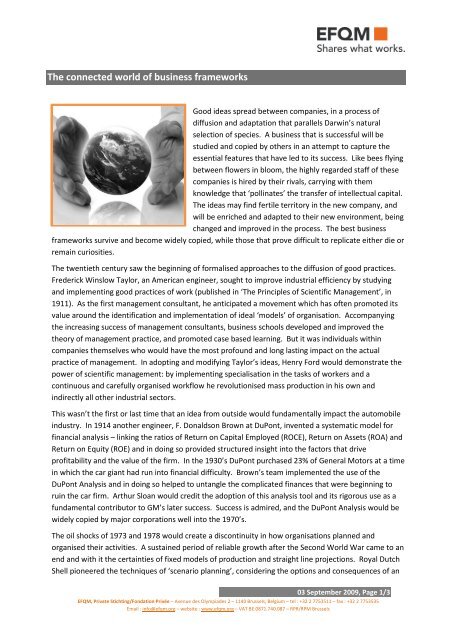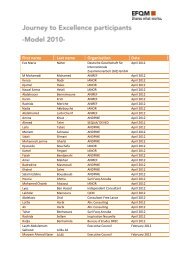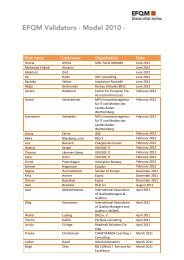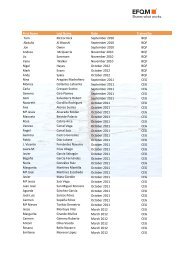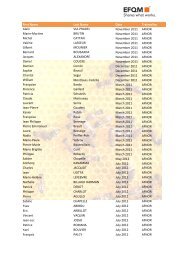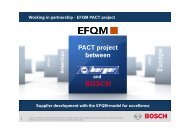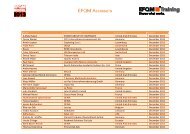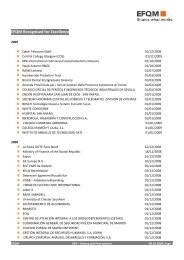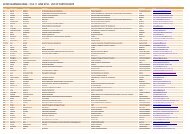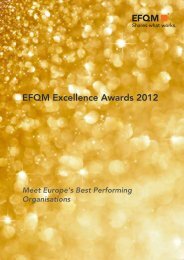The connected world of business frameworks - EFQM
The connected world of business frameworks - EFQM
The connected world of business frameworks - EFQM
You also want an ePaper? Increase the reach of your titles
YUMPU automatically turns print PDFs into web optimized ePapers that Google loves.
<strong>The</strong> <strong>connected</strong> <strong>world</strong> <strong>of</strong> <strong>business</strong> <strong>frameworks</strong><br />
Good ideas spread between companies, in a process <strong>of</strong><br />
diffusion and adaptation that parallels Darwin’s natural<br />
selection <strong>of</strong> species. A <strong>business</strong> that is successful will be<br />
studied and copied by others in an attempt to capture the<br />
essential features that have led to its success. Like bees flying<br />
between flowers in bloom, the highly regarded staff <strong>of</strong> these<br />
companies is hired by their rivals, carrying with them<br />
knowledge that ‘pollinates’ the transfer <strong>of</strong> intellectual capital.<br />
<strong>The</strong> ideas may find fertile territory in the new company, and<br />
will be enriched and adapted to their new environment, being<br />
changed and improved in the process. <strong>The</strong> best <strong>business</strong><br />
<strong>frameworks</strong> survive and become widely copied, while those that prove difficult to replicate either die or<br />
remain curiosities.<br />
<strong>The</strong> twentieth century saw the beginning <strong>of</strong> formalised approaches to the diffusion <strong>of</strong> good practices.<br />
Frederick Winslow Taylor, an American engineer, sought to improve industrial efficiency by studying<br />
and implementing good practices <strong>of</strong> work (published in ‘<strong>The</strong> Principles <strong>of</strong> Scientific Management’, in<br />
1911). As the first management consultant, he anticipated a movement which has <strong>of</strong>ten promoted its<br />
value around the identification and implementation <strong>of</strong> ideal ‘models’ <strong>of</strong> organisation. Accompanying<br />
the increasing success <strong>of</strong> management consultants, <strong>business</strong> schools developed and improved the<br />
theory <strong>of</strong> management practice, and promoted case based learning. But it was individuals within<br />
companies themselves who would have the most pr<strong>of</strong>ound and long lasting impact on the actual<br />
practice <strong>of</strong> management. In adopting and modifying Taylor’s ideas, Henry Ford would demonstrate the<br />
power <strong>of</strong> scientific management: by implementing specialisation in the tasks <strong>of</strong> workers and a<br />
continuous and carefully organised workflow he revolutionised mass production in his own and<br />
indirectly all other industrial sectors.<br />
This wasn’t the first or last time that an idea from outside would fundamentally impact the automobile<br />
industry. In 1914 another engineer, F. Donaldson Brown at DuPont, invented a systematic model for<br />
financial analysis – linking the ratios <strong>of</strong> Return on Capital Employed (ROCE), Return on Assets (ROA) and<br />
Return on Equity (ROE) and in doing so provided structured insight into the factors that drive<br />
pr<strong>of</strong>itability and the value <strong>of</strong> the firm. In the 1930’s DuPont purchased 23% <strong>of</strong> General Motors at a time<br />
in which the car giant had run into financial difficulty. Brown’s team implemented the use <strong>of</strong> the<br />
DuPont Analysis and in doing so helped to untangle the complicated finances that were beginning to<br />
ruin the car firm. Arthur Sloan would credit the adoption <strong>of</strong> this analysis tool and its rigorous use as a<br />
fundamental contributor to GM’s later success. Success is admired, and the DuPont Analysis would be<br />
widely copied by major corporations well into the 1970’s.<br />
<strong>The</strong> oil shocks <strong>of</strong> 1973 and 1978 would create a discontinuity in how organisations planned and<br />
organised their activities. A sustained period <strong>of</strong> reliable growth after the Second World War came to an<br />
end and with it the certainties <strong>of</strong> fixed models <strong>of</strong> production and straight line projections. Royal Dutch<br />
Shell pioneered the techniques <strong>of</strong> ‘scenario planning’, considering the options and consequences <strong>of</strong> an<br />
James Howe 03 September 2009, Page 1/3<br />
<strong>EFQM</strong>, Private Stichting/Fondation Privée – Avenue des Olympiades 2 – 1140 Brussels, Belgium – tel : +32 2 7753511 – fax : +32 2 7753535<br />
Email : info@efqm.org – website : www.efqm.org – VAT BE 0871.740.087 – RPR/RPM Brussels
uncertain future. <strong>The</strong> approach has subsequently been adopted by other major corporations such as<br />
Motorola, Disney and Accenture. Erste Allgemeine Versicherung, an insurance company based in<br />
Austria, first used scenarios in 1988. <strong>The</strong> objective was to look at the <strong>business</strong> environment and<br />
opportunities for growth. <strong>The</strong> company anticipated the fall <strong>of</strong> the Berlin Wall more than a year before<br />
it happened and successfully pioneered investments in Eastern Europe well ahead <strong>of</strong> its competitors.<br />
<strong>The</strong> scenario planning approach is getting more popular. According to Bain & Company’s annual survey<br />
<strong>of</strong> management tools (quoted in the Economist, 1 st September 2008), fewer than 40% <strong>of</strong> companies<br />
used scenario planning in 1999, but by 2006 its usage had risen to 70%.<br />
<strong>The</strong> Spanish fashion giant Zara (part <strong>of</strong> the Inditex group <strong>of</strong> companies) is widely held as an example <strong>of</strong><br />
best practice in logistics: by adopting ‘Lean’ production principles and rationalising the product design<br />
process the company has been able to grow pr<strong>of</strong>itably to become the <strong>world</strong>’s largest fashion retailer.<br />
<strong>The</strong> ‘<strong>connected</strong> <strong>world</strong>’ <strong>of</strong> these ideas can be traced from the practices <strong>of</strong> Frederick Taylor, interpreted<br />
by Ford and perfected by Toyota. However, the truth is that Zara can thank Toyota executives for<br />
spending time studying the retailing sector itself.<br />
In the 1950’s the management team <strong>of</strong> Toyota came to the United States to learn the secrets <strong>of</strong> the<br />
<strong>world</strong>’s largest automobile producing country. <strong>The</strong>y visited Ford, hoping to learn the secrets <strong>of</strong> efficient<br />
production, but came away disappointed. <strong>The</strong> delegation led by the engineer Taiichi Ohno were<br />
appalled by the large amounts <strong>of</strong> inventory on site, by how uneven the amount <strong>of</strong> work being<br />
performed in various departments within the factory was, and the amount <strong>of</strong> rework at the end <strong>of</strong> the<br />
process.<br />
In fact, it was the visit to a supermarket chain operating in the Midwestern and Southern regions <strong>of</strong> the<br />
United States called ‘Piggly Wiggly’ that prompted the most revolutionary idea. Piggly Wiggly had<br />
invented the self service supermarket in 1916, but more significantly to the visitors was pioneering<br />
techniques in efficient stock handling. <strong>The</strong> Japanese visitors were struck by a simple and powerful idea:<br />
goods were only reordered from the warehouse when customers purchased them. A cornerstone <strong>of</strong><br />
the ‘Toyota way’, the famous ‘Just in Time’ replenishment technique was inspired, key to Zara’s later<br />
success.<br />
Perhaps the most widespread <strong>of</strong> all modern management <strong>frameworks</strong> is ‘Six Sigma’, pioneered in<br />
Motorola in the 1980’s. In the early 1980s under Chairman Bob Galvin, Motorola engineers decided<br />
that traditional quality levels, which measured defects in thousands <strong>of</strong> opportunities, were not precise<br />
enough. Instead, they wanted to measure the defects per million opportunities. Motorola developed<br />
this new standard and created the methodology associated with its organisational implementation. Six<br />
Sigma helped Motorola realize impressive improvements: more than $16 Billion in associated savings<br />
were documented from the programme. Since then, hundreds <strong>of</strong> companies around the <strong>world</strong> have<br />
adopted Six Sigma as a way <strong>of</strong> doing <strong>business</strong>.<br />
Despite Six Sigma’s proven contribution to the bottom line <strong>of</strong> many <strong>business</strong>es, there are an increasing<br />
number <strong>of</strong> cases where it has proven disappointing or even negative. <strong>The</strong>re are several cases in which<br />
executives moving outside the manufacturing environment have sought to apply the lessons too<br />
rigorously. One <strong>of</strong> America’s leading retailers, Home Depot, ran into financial difficulty after an<br />
extensive implementation <strong>of</strong> Six Sigma inspired stock handling and administration: its efficiency<br />
increased, but customer satisfaction fell from first to worst among retailers in 2005.<br />
James Howe 03 September 2009, Page 2/3<br />
<strong>EFQM</strong>, Private Stichting/Fondation Privée – Avenue des Olympiades 2 – 1140 Brussels, Belgium – tel : +32 2 7753511 – fax : +32 2 7753535<br />
Email : info@efqm.org – website : www.efqm.org – VAT BE 0871.740.087 – RPR/RPM Brussels
<strong>The</strong> approach has run into particular difficulty in <strong>business</strong> environments that depend on creativity and<br />
innovation for their continued success. <strong>The</strong> advertising executives at Young & Rubicam, rebelled<br />
against the initiative <strong>of</strong> their new CEO (a former GE board member), after she tried to implement Six<br />
Sigma. Under new leadership, 3M is reconsidering how and where it applies Six Sigma in an effort to<br />
reinvigorate innovation at the company.<br />
<strong>The</strong> history <strong>of</strong> management <strong>frameworks</strong>, including Six Sigma, is one <strong>of</strong> evolution in which new and<br />
successful ideas are copied, spreading beyond the frontiers <strong>of</strong> their original application until they find<br />
new terrain for growth or encounter failure. Depending on how the framework is adapted to these<br />
different circumstances it will either get stronger or change into something else.<br />
In the next article, we will consider the evolution <strong>of</strong> the <strong>EFQM</strong> Excellence framework, and how it too is<br />
the product <strong>of</strong> adaptation in a <strong>connected</strong> <strong>world</strong>.<br />
James Howe 03 September 2009, Page 3/3<br />
<strong>EFQM</strong>, Private Stichting/Fondation Privée – Avenue des Olympiades 2 – 1140 Brussels, Belgium – tel : +32 2 7753511 – fax : +32 2 7753535<br />
Email : info@efqm.org – website : www.efqm.org – VAT BE 0871.740.087 – RPR/RPM Brussels


